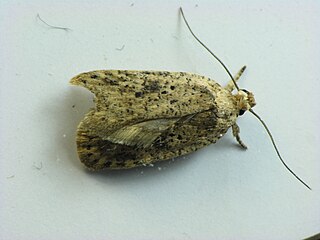| Depressaria alienella | |
|---|---|
| Scientific classification | |
| Kingdom: | |
| Phylum: | |
| Class: | |
| Order: | |
| Family: | |
| Genus: | |
| Species: | D. alienella |
| Binomial name | |
| Depressaria alienella Busck, 1904 | |
| Synonyms | |
| |
Depressaria alienella is a moth in the family Depressariidae. It was described by August Busck in 1904. [1] It is found in North America, where it has been recorded from Yukon to Nova Scotia, south to New England, Arizona and California. [2]

Moths comprise a group of insects related to butterflies, belonging to the order Lepidoptera. Most lepidopterans are moths, and there are thought to be approximately 160,000 species of moth, many of which have yet to be described. Most species of moth are nocturnal, but there are also crepuscular and diurnal species.

Depressariidae is a family of moths. It has formerly been treated as a subfamily of Gelechiidae, but is now recognised as a separate family, comprising about 2300 species worldwide.
August Busck was a Danish entomologist who became an American citizen. Busck was an employee of the Bureau of Entomology within USDA. He is best known for his work with microlepidoptera, of which he described over 600 species. His collections of Lepidoptera from North America and the Panama Canal Zone are held by the National Museum of Natural History in Washington, D.C.
The wingspan is 18–21 mm. The forewings are light fuscous overlaid with red or reddish fuscous, irrorated with cinereous and fuscous and streaked with blackish fuscous. There is a white discal spot at the end of the cell, preceded and followed by fuscous. There is an ill-defined row of fuscous spots around the termen. [3] The hindwings are pale grey with light brownish shading in the outer half. Adults are on wing from July to September. [4]

The wingspan of a bird or an airplane is the distance from one wingtip to the other wingtip. For example, the Boeing 777-200 has a wingspan of 60.93 metres, and a wandering albatross caught in 1965 had a wingspan of 3.63 metres, the official record for a living bird. The term wingspan, more technically extent, is also used for other winged animals such as pterosaurs, bats, insects, etc., and other fixed-wing aircraft such as ornithopters. In humans, the term wingspan also refers to the arm span, which is distance between the length from one end of an individual's arms to the other when raised parallel to the ground at shoulder height at a 90º angle. Former professional basketball player Manute Bol stands at 7 ft 7 in (2.31 m) and owns one of the largest wingspans at 8 ft 6 in (2.59 m).
The larvae feed on the flowers of Artemisia and Achillea species. [5]

Artemisia is a large, diverse genus of plants with between 200 and 400 species belonging to the daisy family Asteraceae. Common names for various species in the genus include mugwort, wormwood, and sagebrush.

Achillea is a group of flowering plants in the family Asteraceae described as a genus by Linnaeus in 1753.